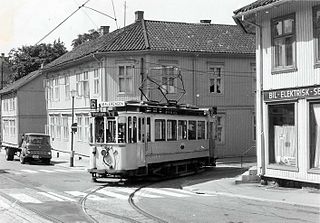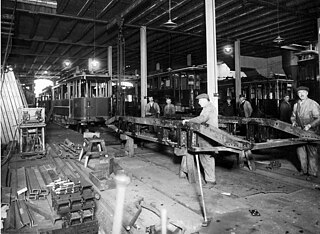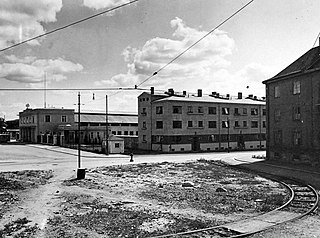Related Research Articles

Jernbanetorget or Jernbanetorvet is both a rapid transit station on the Oslo Metro and a tram stop of the Oslo Tramway. The metro station is in the Common Tunnel used by all lines under the city centre. It is located between Stortinget to the west and Grønland to the east. Until the construction of the station at Stortinget, Jernbanetorget was the end station for the eastern lines in downtown. Along with the Oslo Central Station, Oslo Bus Terminal and the tram and bus station above ground, Jernbanetorget is the largest transport hub in Norway.

AS Oslo Sporveier is a defunct municipal owned company responsible for public transport in Oslo, Norway. It was created in 1924 to take over the city's two private tram companies. In 1927 its started with bus transport, including from 1940 to 1968 trolleybuses. Since 1966 rapid transit and from 1985 water buses have also been operated by the company. It was split into two separate companies in 2006; Kollektivtransportproduksjon took over the operation while Oslo Public Transport Administration was responsible for buying the services, fare regulation and marketing. The latter merged into Ruter in 2008, when the Oslo Sporveier brand was discontinued.

The Sagene Line is a former line of the Oslo Tramway in Norway. It ran from Stortorvet in the city center along Akersgata and Ullevålsveien through the neighborhood of St. Hanshaugen. It then continued along Colletts gate, Geitmyrsveien and Kierschouws gate to Sagene. At Sagene Church it had a regulation stop and access to Sagene Depot. The line continued along Bentsebrugata to Torshov, where it intersected with the Grünerløkka–Torshov Line.

Ruter AS is the public transport authority for Oslo and Akershus counties in Norway. Formally a limited company – 60% of its shares are owned by the Oslo county municipality and 40% by that of Akershus – it is responsible for the administration, funding, and marketing of public transport in the two counties, including buses, the Oslo Metro, Oslo Trams, and ferry services. Ruter also holds agreements with Entur concerning the regulation of fares on local and regional train services operated within the two counties.
A/S Kristiania Sporveisselskab or KSS, nicknamed the Green Tramway, was an operator of part of the Oslo Tramway from 1875 to 1924. The company was established in 1874 and started with horsecar operations on the Ullevål Hageby Line, Gamlebyen Line and the Grünerløkka–Torshov Line. The network was electrified with in 1899 and 1900, whereby the company was bought by Union-Elektricitäts-Gesellschaft. It delivered new Class U trams. Within a few years the company had also opened the Vålerenga Line and Kampen Line. It took over Kristiania Kommunale Sporveie in 1905, taking over its fleet of Class S trams and the Sagene Ring, the Vippetangen Line and the Rodeløkka Line.

Vippetangen is the southern tip of the Akersnes peninsula in central Oslo, Norway, located southeast of Akershus Fortress and bounded on three sides by the Oslofjord. It has in the past served as an important part of the port of Oslo. The area is currently undergoing urban renewal as part of the Fjord City development.

Kristiania Kommunale Sporveie or KKS, colloquially known as the Red Tramway was a municipal owned company that operated parts of the Oslo Tramway from 1899 to 1905. KKS built and operated three lines, Sagene Ring, the Rodeløkka Line and the Vippetangen Line. The three were connected by means of lines of Kristiania Sporveisselskab (KSS) and Kristiania Elektriske Sporvei (KES). KKS bought twenty motorized trams from Schuckert & Co. and twelve trailers, designated as Class S. It built two depots, Sagene and Rodeløkka.
A/S Kristiania Elektriske Sporvei or KES, nicknamed the Blue Tramway, was a company which operated part of the Oslo Tramway between 1894 and 1924. It built a network of four lines in Western Oslo, the Briskeby Line and the Frogner Line which ran to Majorstuen, and two other consecutive lines, the Skøyen Line and the Lilleaker Line. These all connected to a common line through the city center which terminated at Jernbanetorget.

The Ullevål Hageby Line is a light rail section of the Oslo Tramway. It runs from Stortorvet in the city center of Oslo, Norway to Rikshospitalet. It passes through the areas of St. Hanshaugen, Ullevål Hageby and Blindern before reaching Gaustad. It serves major institutions such as Oslo University College, Bislett Stadion, Ullevål University Hospital, the University of Oslo and Rikshospitalet. The line is served by route 17 and 18 by Oslo Sporvognsdrift using SL95 trams, while the tracks are owned by Kollektivtransportproduksjon.

The Briskeby Line is a line of the Oslo Tramway in Norway. It runs westwards from Jernbanetorget in the city center, passing through the neighborhoods of Briskeby and Uranienborg before reaching its terminus at Majorstuen. The section from Jernbanetorget to Inkognitogata is shared with the Skøyen Line; on this section it connects with the important transport hub Nationatheatret. This part is variously served by route 11, 12 and 13. From the Inkognitogata stop, the line moves through the residential areas around the Royal Palace, in the streets named Riddervolds gate, Briskebyveien, Holtegata and Bogstadveien. The part of the line in Bogstadveien from Majorstuen to Rosenborg is also served by route 19, which operates the Homansbyen Line.

The Vika Line is a light rail section of the Oslo Tramway in Oslo, Norway. It runs between Wessels plass, through the neighborhood of Vika and Aker Brygge, before arriving at Solli. The section is served by SL79 trams on line 12. The line is owned by the municipal company Kollektivtransportproduksjon, and operated by its subsidiary Oslo Sporvognsdrift.

The history of the Oslo Tramway and Oslo Metro in Oslo, Norway, starts in 1875, when Kristiania Sporveisselskab (KSS) opened two horsecar lines through the city centre. In 1894, Kristiania Elektriske Sporvei (KES) built the first electric street tramways, which ran west from the city centre. Within six years, all tramways were electric. The city council established Kristiania Kommunale Sporveie (KKS) in 1899, which built three lines before it was sold to KSS six years later. Both KSS and KES were taken over by the municipality in 1924, becoming Oslo Sporveier. The company gradually expanded the city tram network, which reached its peak length in 1939.

The Rodeløkka Line is a former line of the Oslo Tramway of Norway. It was in use from 1900 to 1961, serving the neighborhood of Rodeløkka. After closing, the southern part of the line was designated as part of the Sinsen Line. The Rodeløkka Line was built by Kristiania Kommunale Sporveie (KKS) in 1900, and was subsequently taken over by Kristiania Sporveisselskab (KSS) in 1905. In 1924, the ownership was transferred to Oslo Sporveier. It was served by Line 9 until 1949, when it was replaced by a bus service. In 1955, a new route from Carl Berners plass to Rodeløkka was built, and the line was served by Line 13 until 1961, when the service was terminated. The tracks were removed between 1962 and 1964.

The Vålerenga Line, also known as Helsfyr Line and Etterstad Line, is an abandoned line of the Oslo Tramway of Norway. It branched from the Gamlebyen Line in Schweigaards gate and ran into the neighborhoods of Vålerenga, Etterstad and Helsfyr. The line followed the streets of Schweigaards gate, St. Halvars gate, Enebakkveien, one direction each in Vålerenggata and Strømsveien, and Etterstadgata. The line continued as a suburban light rail as the Østensjø Line and the Lambertseter Line.

Homansbyen Depot, officially Kristiania Sporveisanlæg was an Oslo Tramway depot located at Sporveisgata 8 near Bislett in Oslo, Norway. It was constructed for Kristiania Sporveisselskab in 1874 and was the first tramway depot in the country. The facilities were designed by Henrik Thrap-Meyer and featured an administrative office, a horse stable, a forge, a workshop, a weighing shed, and a wagon depot. It had space for 28 horse wagons, 16 sleds, and 116 horses. The administrative office was built in brick and housed apartments, offices, and a laboratory for the veterinarian. The depot was reconstructed several times, and taken out of use in 1966. It was demolished three years later, and replaced with residential apartment blocks.
Rodeløkka Depot was a tram depot located in Verksgaten at Rodeløkka in Oslo, Norway.

Class S was a class of 20 twin-axle trams and 12 trailers built by Schuckert & Co. and Busch for Kristiania Kommunale Sporveie (KSS) in 1899. The trams were originally 7.8 meters long and 2.0 meters wide. They featured wooden benches in the longitudinal direction seating twenty. The motor cars had two motors providing a combined power output of 51 kilowatts (68 hp). The motor cars weighed 9.3 tonnes, while the trailers weighed 6.4 tonnes.

The Korsvoll Line is a former line of the Oslo Tramway in Norway. The line branched off from the Sagene Line at Bentsebrugata and ran along Bergensgata to Lisa Kristoffersens plass in Korsvoll, Oslo. The line opened on 1 May 1924 and was operated by Oslo Sporveier. From 1927 it became part of Line 10, which it remained part of until its closing on 17 January 1949. The reason for closing the line was that it was amongst the least trafficked lines of the tramway and Oslo Sporveier wanted to convert it to a trolleybus line.

Sandaker senter is a tram stop on the Grünerløkka–Torshov Line of the Oslo Tramway network. It is located in the borough of Sagene in Oslo, Norway. Sandaker senter is right next to the mall It is also located near Sagene Fire Station and a mill called Bjølsen Valsemølle. This mill was part of the former Grain Tram system, in which special trams transported grain from the silos at Vippetangen. They stopped transporting grain in 1967, after running for 49 years.
References
- ↑ Fristad 1987, p. 102.
- ↑ Aspenberg 1994, p. 28.
- ↑ Oslo Waterfront Planning Office (16 November 2006). "Tilgjengelighet i Fjordbyen Del 3 Prinsipper for transportsystemet" (PDF). p. 87.
- Bibliography
- Aspenberg, Nils C. (1994). Trikker og forstadsbaner i Oslo (in Norwegian). Oslo: Baneforlaget. ISBN 82-91448-03-5.
- Fristad, Hans A. (1987). Oslo-trikken: Storbysjel på skinner (in Norwegian). Oslo: Gyldendal Norsk Forlag. ISBN 82-05-17358-3.